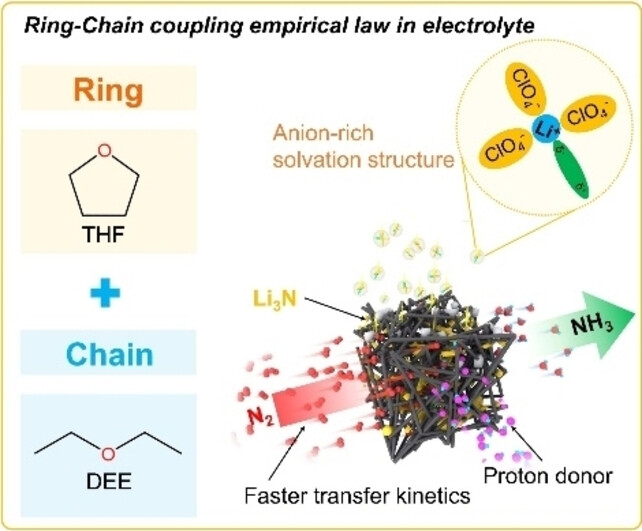Extending Ring-Chain Coupling Empirical Law to Lithium-Mediate Electrochemical Ammonia Synthesis
Ya Li1, Zhenkang Wang3, Haoqing Ji3, Mengfan Wang3, Tao Qian4*(钱涛), Chenglin Yan2,3*(晏成林), Jianmei Lu1*(路建美)
1Collaborative Innovation Center of Suzhou Nano Science and Technology, College of Chemistry Chemical Engineering and Materials Science, Soochow University 199 Ren’ai Road, Suzhou 215123 (P. R. China)
2School of Petrochemical Engineering, Changzhou University Changzhou 213164 (P. R. China)
3Key Laboratory of Core Technology of High Specific Energy Battery and Key Materials for Petroleum and Chemical Industry, College of Energy, Soochow University Suzhou, Jiangsu 215006 (P. R. China)
4College of Chemistry and Chemical Engineering, Nantong University Nantong, Jiangsu 226019 (P. R. China)
Angew. Chem. Int. Ed. 2024, 63, e202311413
Abstract: With its efficient nitrogen fixation kinetics, electrochemical lithium-mediated nitrogen reduction reaction (LMNRR) holds promise for replacing Haber-Bosch process and realizing sustainable and green ammonia production. However, the general interface problem in lithium electrochemistry seriously impedes the further enhancement of LMNRR performance. Inspired by the development history of lithium battery electrolytes, here, we extend the ring-chain solvents coupling law to LMNRR system to rationally optimize the interface during the reaction process, achieving nearly a two-fold Faradaic efficiency up to 54.78 ± 1.60%. Systematic theoretical simulations and experimental analysis jointly decipher that the anion-rich Li+ solvation structure derived from ring tetrahydrofuran coupling with chain ether successfully suppresses the excessive passivation of electrolyte decomposition at the reaction interface, thus promoting the mass transfer of active species and enhancing the nitrogen fixation kinetics. This work offers a progressive insight into the electrolyte design of LMNRR system.

链接://onlinelibrary.wiley.com/doi/10.1002/anie.202311413